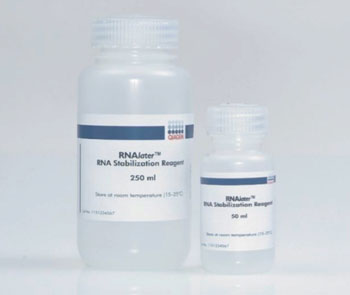Innovative Approach Developed for Sampling Gut Bacteria
By LabMedica International staff writers
Posted on 04 Jun 2014
A new protocol for collecting saliva and stool samples for genomic and transcriptomic analyses has been developed which eliminates the need for specialized personnel and facilities while keeping the sample intact.Posted on 04 Jun 2014
The protocol provides critical insight into the genetic makeup of the microbiome of the digestive tract and the bacteria associated with celiac disease, oral cancer, periodontitis, and obesity and this technique will enable both longitudinal studies and large collection studies that are not limited by geography.

Image: RNAlater, ribonucleic acid stabilization reagent (Photo courtesy of Qiagen).
Scientists at the Forsyth Institute (Cambridge, MA, USA) with colleagues from other institutes conducted one of the first human microbiome studies in a well-phenotyped prospective cohort incorporating taxonomic, metagenomic, and metatranscriptomic profiling at multiple body sites using self-collected samples. Eight male subjects provided self-collected stool and saliva samples for shotgun metagenomic and metatranscriptomic sequencing.
To evaluate the effects of sample handling method on the assays, each stool sample was subdivided to produce three aliquots: a fresh frozen control sample, a sample fixed in ethanol, and a sample fixed in RNAlater (Qiagen; Valencia, CA, USA). From among the participants of a Health Professionals Follow-up Study, they selected 63 men who represented extremes of western versus prudent dietary intake and sent them kits for self-collection of saliva and stool at home. All DNA-based samples were then sequenced by Illumina HiSeq (San Diego, CA, USA), with each DNA sample run on a single sequencing lane, and each ribonucleic acid (RNA), (complementary DNA, cDNA) sample run on a pair of sequencing lanes.
The scientists found that within-subject microbial species, gene, and transcript abundances were highly concordant across sampling methods, with only a small fraction of transcripts less than 5%, displaying between-method variation. The team investigated relationships between the oral and gut microbial communities, identifying a subset of abundant oral microbes that routinely survive transit to the gut but have minimal transcriptional activity there. Systematic comparison of the gut metagenome and metatranscriptome revealed that a substantial fraction of 41% of microbial transcripts was not differentially regulated relative to their genomic abundances.
Jacques Izard, PhD, a coauthor of the study said, “We are excited about the opportunities this protocol presents for future large-scale studies. As the sensitivity of the sequencing technologies and the computing tools are improving, minute change can be detected. Our collaborative group demonstrated that we can analyze samples self-collected and shipped, in confidence for future biological marker discovery.” The study was published on May 19, 2014, in the journal Proceedings of the National Academy of Sciences of the United States of America (PNAS).
Related Links:
Forsyth Institute
Qiagen
Illumina













